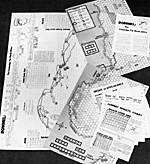
The first one to arrive in our office was Rommel: The Campaign for North Africa (hereafter referred to as Rommel). It is available from Loren Sperry, 1014 N. 4th Street, Sheboygan, Wisconsin, 53081. Priced at $5.00 with 50 cents postage. It is a divisional level simulation of the North African campaign (eastern Libya and western Egypt) with action from September 1, 1940 to December of 1942.
You receive a one piece unmounted black and white mapboard 23" by 35". The board is standard hexagon with escarpment, road, town, salt marshes, and a special Qattara Depression feature. There are some partial hexes that could cause definite arguments. Printed on the map is the time chart, arrival and withdrawal schedule, Combat Results Table (CRT), terrain effects chart, and the substitute strength system chart. The simulation uses step reduction for the units.
The counters are in three colors, but are not die cut, and not mounted. They are made of a thick paper as in Centurion (early S&T magazine simulation) with perforated edges. It is unfortunate that they aren't mounted, though one can do that job oneself. You also receive a die with Rommel and a rule sheet with some limited comments upon the campaign. The campaign scenario is divided into four minor "battle games" of a more reasonable play length.
Mr. Sperry does not list the credits, but it can be safely said that he designed Rommel, worked intimately with the playtesting, and produced it. It should be added that Rommel arrived quickly and was ready to be sold before it was advertised on the market.
Mr. Sperry was kind enough to let us quote from an article on the design of Rommel that will appear in a future issue of the Spartan Journal:
- Rommel . . . was born years ago, as I played my first wargame, Avalon Hill's Afrika Korps... then, as my interest in the North African Campaign of World War II increased and I
read more and more on the subject, I found that, while highly playable, Afrika Korps was lacking in accuracy: not only historically but in the simulation of warfare.
Mr. Sperry goes on to complain about the lack of step reduction, no allowance for withdrawal and arrival of units of the Allied Army, and the need for mines, forts, and airpower among other points.
Mr. Sperry has made an attempt to repair these situations. He proceeded to forego some historical accuracy to make a playable simulation. For example, he has the 21st Panzer Division arriving in a very weak condition stepwise. It was most likely done so that in one of his mini-games, the Axis would not win an overwhelming victory over the allies. Mr. Sperry does produce a playable simulation. It is more historically accurate than Afrika Korps. But there are some serious problems that point out the amateur level of this simulation.
The physical quality is not professional, though his service is. This is his first effort, and he has mentioned problems in finding a die cutter and a competent printer for his specialized needs. The physical quality, however, is one reason that Rommel may be received poorly by the general public. Physically it is not worth $5.50.
Any simulation in which you have troops withdrawing or reappearing presents problems. Historically it may be very accurate. But I find it hard to believe that several divisions would be withdrawn to Greece or Cyprus with the Suez directly threatened. This often happens in Rommel as well as in other simulations.
The rules are another problem. They are poorly written and present many possibilities for argument. Joe Wes, one of our playtesters said, "These rules are written as if for a variant of a game you already know."
We were constantly referring to the rules and not finding the answer. These problems can be worked out by two players, but they must make an effort to compromise and think out certain rule interpretations (e.g., do Zones of Control extend into enemy occupied hexagons?). Most likely this problem originated in the fact that most playtest panels are incestuous. They play among themselves and therefore hold the same ideas and prejudices. Furthermore, there is a real skill required in writing rules.
Another problem is research. Mr. Sperry read most of the standard works on this campaign. However, no mention of any of the official histories is made, with one exception. Playfair's four volume official history is ignored while Beda Fomm in the Ballantine history is not. Granted these are extremes, but a little more research would have cleaned up some problems, such as initial Italian dispositions.
If one wants a new, playable desert campaign simulation, which one will have to work on and which is more accurate than Afrika Korps, he should choose Rommel.
Introduction
Review: Rommel
Review: Desert Fox
Review: Kasserine Pass
Back to Conflict Number 6 Table of Contents
Back to Conflict List of Issues
Back to MagWeb Master Magazine List
© Copyright 1973 by Dana Lombardy
This article appears in MagWeb (Magazine Web) on the Internet World Wide Web.
Other military history articles and gaming articles are available at http://www.magweb.com